The Ultimate Guide to Start a Blog and Make Passive Online Income
As a blogger, you can make money from home. Successful bloggers have made over $10,000 per month. Blogging provides a solution on how to make money from home. This article provides a to the point guidance on how to make money online through being a blogger. |
|---|
| 1.Pick your blog’s name and niche |
| 2.Get your blog online (web hosting) |
| 3.Design your blog with a free WordPress theme |
| 4.Write your first blog post |
| 5.Promote your blog and get readers |
| 6.Make money from your blog |
If you’re ready to take the leap and learn how to start a blog that can grow into a source of real online income, then let’s dive in.
1. Pick your blog’s name and niche
First, it’s time to select a reputation and niche for your new blog.
The name of your blog is what readers will see first (like yourblog.com), so it should ideally represent either the overall topics you’ll be writing about—or it might be your own name, that of your business, an ingenious combination of words, or otherwise.
Your blog’s niche is that the general topic area that you’ll be focusing your content around. Examples include topics like travel, food, fashion, lifestyle, technology, and otherwise. Incorporating a word or two that clearly signals what your content is about, within the name of your blog (like fashionbyjane.com or watchryanhike.com)—will be very helpful for your future blog readers.
2. Get your blog online (web hosting)
The second step in starting a blog is really getting your blog online. That’s what an internet hosting company will do for you. during this step, you’ll be selecting the blogging platform and web hosting plan you’ll use to urge your blog online.
The combination of blogging platform & web hosting I personally use (and that the majority of other bloggers use) may be a WordPress blog, hosted by Bluehost. WordPress may be a free publishing platform that’s been around since 2003 and now powers quite 60% of all blogs on the web. Bluehost is one of the foremost established, reliable companies within the blog hosting industry. this mix is what we’ll be using to start out your blog. Now, let’s get your hosting found out.
—> Click here to head over to Bluehost and hit the green “Get Started Now” button
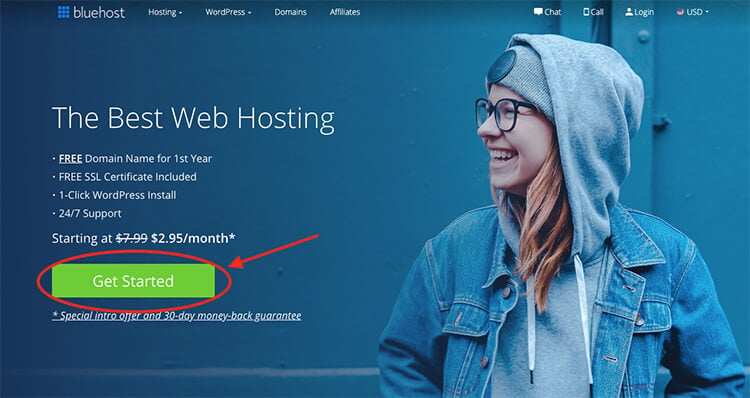
Choose your plan
First, you’ll select a hosting plan (inputting your blog name comes next). Personally, I like to recommend choosing the selection Plus plan because it comes with Domain Privacy, which can protect your personal information (your full name, email address, telephone number, and residential address) from being published anywhere online.
Choosing your plan will appear as if this is right here. Just click the green “Select” button on your plan of choice:
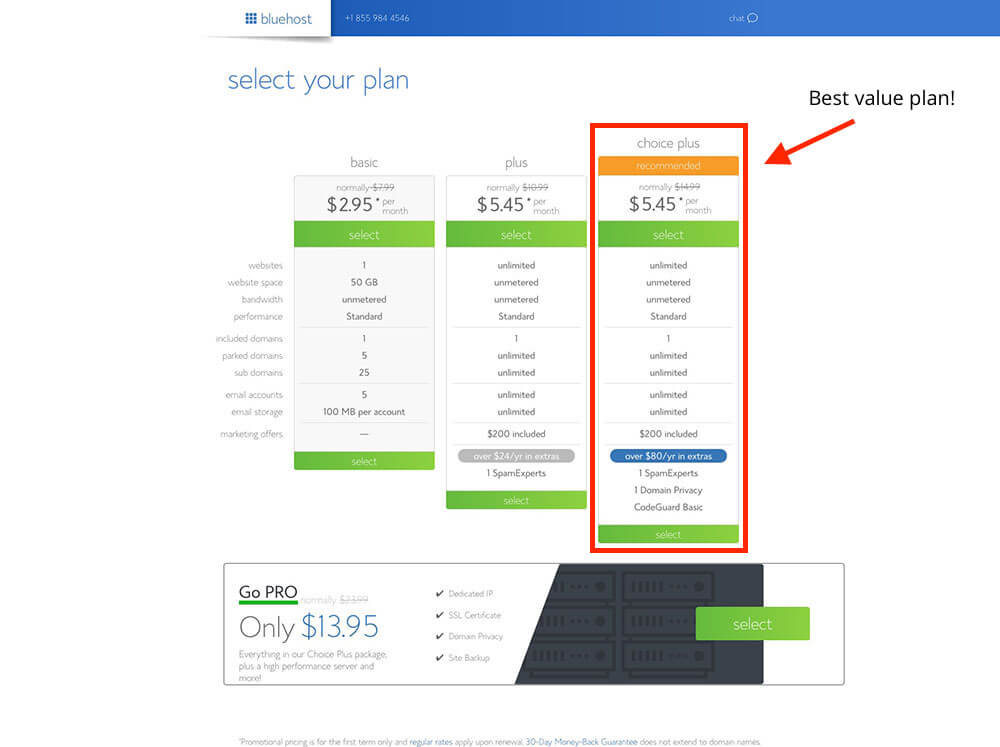
As I said above, i like to recommend choosing the selection Plus plan, in order that you’re getting the Domain Privacy feature that’ll protect your personal information online, but any of those plans will do as you’re starting your blog—and you'll add the domain privacy in later during the checkout process for around $1/mo.
Pick your blog’s name
Next, you’ll get to the page where it’s time to settle on your blog’s domain name:
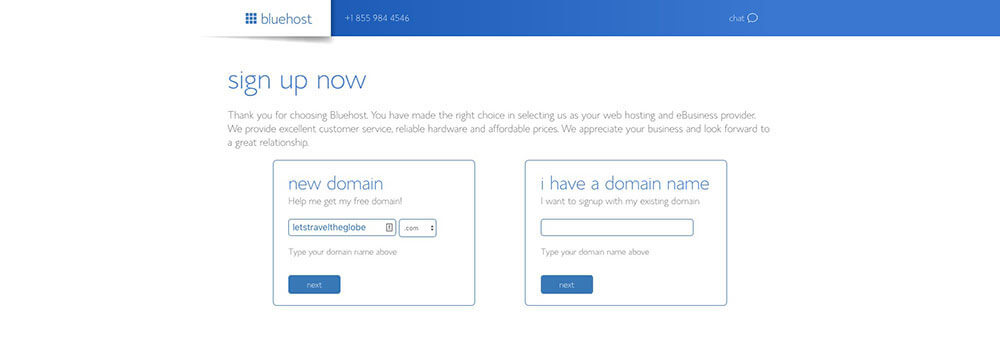
Once you get to the present step within the checkout process, just type within the name of the name that you’d like your blog to possess (legitinternetincome.com).
If you would like to run a fast search to ascertain if your name is out there , you'll roll in the hay quickly right here:
Check if your domain name is available:
If your name of choice isn’t available, you'll either try an alternative choice that involves mind—or (what I recommend) select the choice to settle on your name later after getting the remainder of your account squared away and taking a touch longer to think the name through. Plus, afterward down during this guide, I expand some more on the way to choose the proper name for your blog if you’re not decided yet.
Here’s where you'll click to settle on your domain later (it’s a popup which will appear if you hover on this page for long enough or move your mouse up toward the highest of the page):
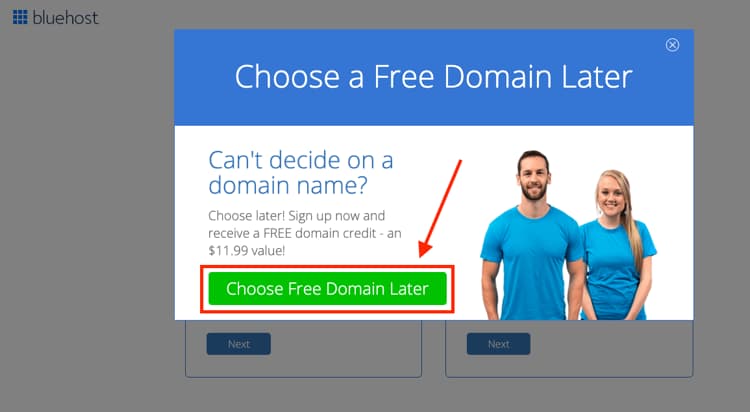
After either choosing your name or opting to pick it later, you’ll be taken to the ultimate step within the check in process—creating your account.
Create your Bluehost account
Start by filling in your account details like your name, email address (it’s super important to use an up-to-date email address because this is often where your login details and account information are going to be sent) and address. If you don’t want to enter your information manually, you'll connect your Bluehost account together with your Google account. Either works!
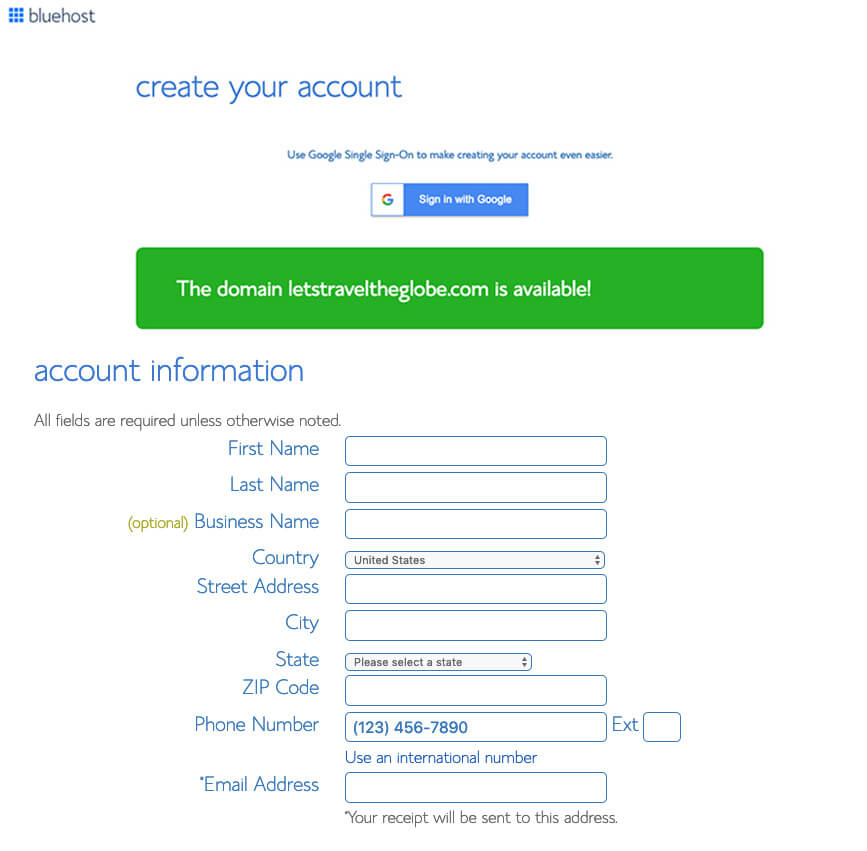
Select the right hosting package
This is where you’ll choose an account plan based on the price you want to lock in and how far in advance you’ll pay.

Note that Bluehost only offers options for you to pay 1, 2, 3 or 5 years upfront. They don’t offer a monthly payment option (because most hosting companies that do offer monthly payments tend to charge a touch more). Even still, with whichever plan you select, the worth works bent to be an excellent deal for starting your own blog and getting it online today.
Which pricing plan is best to start out a blog with?
Personally, I like to recommend choosing the “Prime 36 Month Price” if you would like to lock within the lowest possible price for your hosting. That’s what I exploit. And it secures your blog hosting at its lowest rate (and gets you domain privacy) for the subsequent 3 years. and since this low pricing for brand spanking new customers only applies to the primary payment you create, if you were to settle on the 1-year plan, your pricing may go up than the first year.
That’s why if you select the 36-month plan, your pricing is going to be locked in at this rate for 3 years. For that reason, I like to recommend going with the longest duration plan that your budget can spring for.
Choosing the proper package extras (skip about one)
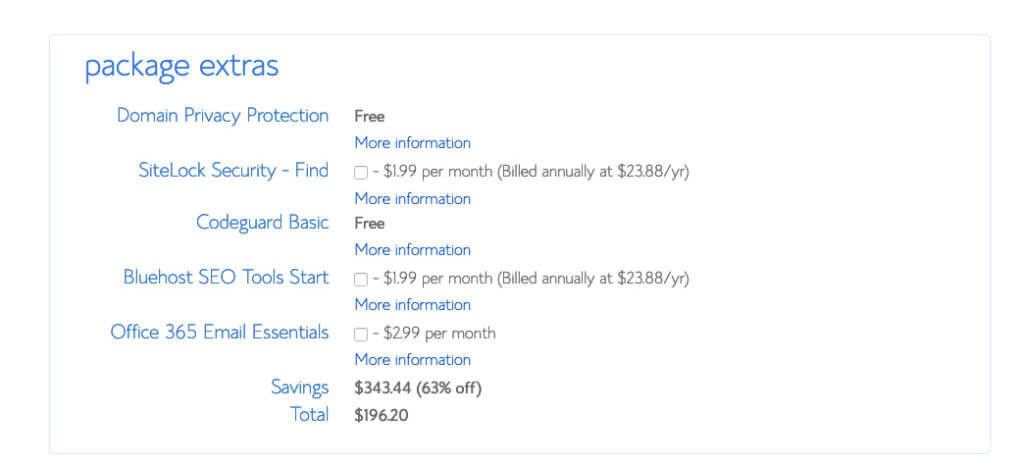
I recommend keeping the Domain Privacy Protection extra, but you'll escape by skipping the remainder. Afterward, during this guide, I’ll show you the various free and cheap plugins & tools you'll use for things like SEO optimization, additional security, and site back-ups, rendering most of the opposite package extras not necessary.
As I discussed earlier though, having the domain privacy extra keeps all of your personal contact information (your name, email, telephone number, and address) private. Now, if you chose the selection Plus Plan on the previous screen, then your Domain Privacy Protection is going to be listed as “Free” a bit like this screenshot above shows—it’s included therein plan.
If you chose a Basic or Plus Plan, then you’ll want to see the box to feature Domain Privacy Protection to your order for around $1/mo.
The total you’ll now see is that the amount you’re getting to pay today. Remember though, you won’t need to pay again for 1, 2, 3, or 5 years counting on the package you chose. Plus, there’s a 30-day refund guarantee just in case things don’t go as planned together with your blog.
Enter your billing information
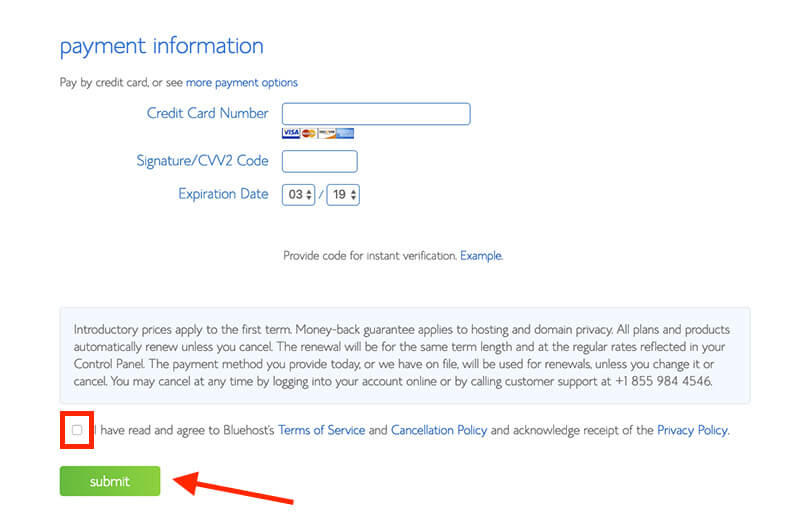
Now you’ll input your billing information, check the box that you agree to Bluehost’s Terms of Service, and then hit the green “Submit” button.
Woo! It’s time for a mini celebration 🙂
You’ve officially completed the first major step in starting a blog.
With the initial signup process complete, it’s time to move into the next stage of getting your blog fully set up and optimized.
On the next page, you’ll be guided step-by-step through the process of getting WordPress installed on your blog through Bluehost—and later on, in this guide, I’ve got a ton of helpful tips for optimizing your blog, free and cheap plugins you can install to help get your blog looking great, and more.
Now, if you haven’t yet set up your web hosting and want to check out some other options—there are other web hosting providers worth considering.
The 2 best alternative blog hosting platforms worth considering
- Dreamhost — I’ve hosted literally dozens of websites on Dreamhost over the years (and I still do). All similar features like 1-click WordPress install, free SSL certificate, and site security aside, one of the biggest pros of going with Dreamhost compared to other hosting companies is that they offer a true pay-per-month plan that allows you to pay for the cost of your blog hosting each month with no strings attached. Here are a few other web hosting companies that also offer monthly payment plans.
- HostGator — The thing that sets HostGator apart from other hosting companies, is their fantastic level of customer support and the fact that they also offer a true monthly payment plan (which helps if you’re starting your blog on a budget). HostGator ranks amongst the largest hosting companies, now powering over 8 million+ websites around the world, making them a great partner to scale your blog with over time.
If you still want to evaluate more of the top blog hosting providers, then head on over to my breakdown of the best web hosting plans for bloggers to review this year.
Now we’re at the point in this guide where everything from here on out will be built upon the assumption that you’ve already registered your domain name and chosen the right hosting plan—so if you haven’t done so already, take just a few minutes to quickly get that set up.
Ready to register your domain name and set up blog hosting?
I made this in-depth video tutorial to walk you step-by-step through the entire process:
Disclosure: Please note that when you purchase hosting using my Bluehost affiliate link, they compensate me, which helps me make this ultimate guide to starting a blog free of charge to you. Know that I also use Bluehost hosting, and I would never recommend a product, tool or service I don’t personally use & advocate for 🙂
3. Design your blog with a free WordPress theme

Now that we’ve gotten through the crucial setup phase of starting a blog, it’s time to have a little more fun.
Designing your WordPress blog is when you might start to feel a little friction with this process though (if you’ve never worked on a blog before), but I promise this won’t get too technical.
If you want to start a blog and make money from it, WordPress is your smartest option
Let’s cover some basic terminology, so you understand why WordPress is the right platform (also known as a Content Management System or CMS) to run your blog on.
Since I first started blogging over a decade ago, I’ve been running my blog on WordPress and I couldn’t be happier with the amount of flexibility, control and long-term growth potential that decision has afforded me.
Now, one thing you need to be careful of, is that WordPress comes in two very different platforms. There’s WordPress.com and WordPress.org. They have almost the same name, but there are very big differences between the two:
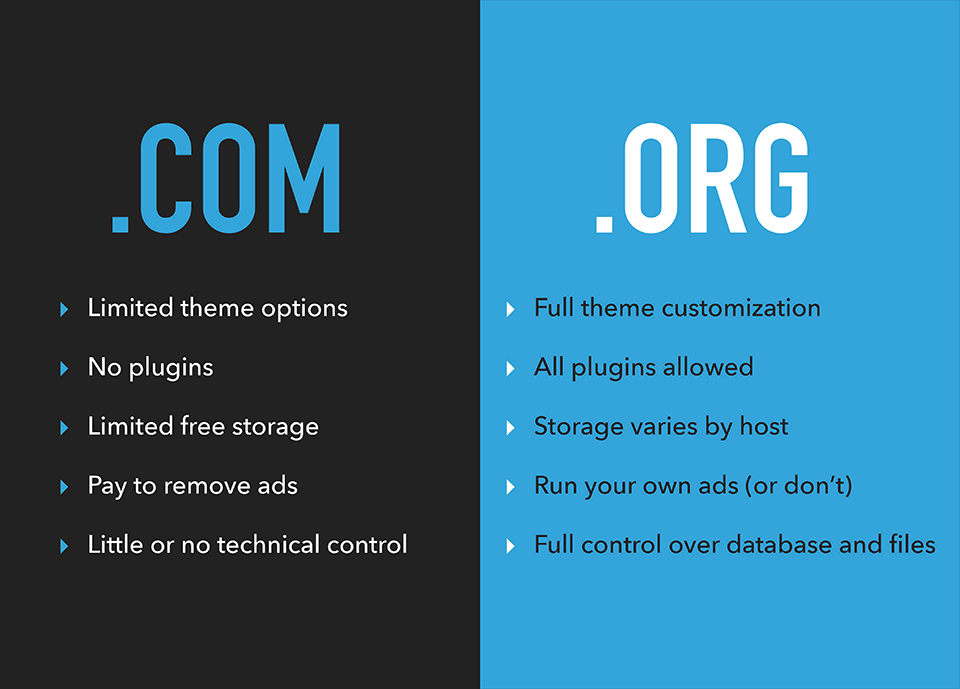
WordPress.com:
- Is free to use (with heavy restrictions)
- Doesn’t let you pick a custom domain name (i.e. 👉 yoursite.wordpress.com)
- Has very limited monetization options (you can’t sell your own ads)
- Doesn’t let you upload plugins (for email capture and other things)
- Has limited theme support so you’re stuck with very basic designs
- You have to pay to remove WordPress branding and get your own domain like yoursite.com
- Limited SEO and analytics
WordPress.org:
- Fully customizable design, unlimited plugin options, and no branding
- Total control over your own monetization efforts
- Powerful SEO features (so people can find your site easier)
- Let’s you start or add an eCommerce store or membership site
- Small monthly fee (from the cheap hosting plan you use to get your blog online)
While the choice is yours, if you want to take full advantage of your blog, be able to have it grow with you and eventually make money from it, WordPress.org is the way to go (and the exact process we’ve followed throughout this guide). It’s the CMS of choice that’ll sit in the background and power your blog.
How to install WordPress (and configure your blog settings)
Here’s a step-by-step video walkthrough of how to install WordPress on your new blog and configure the right settings:
Naturally, in this one video, we don’t cover everything about WordPress, but remember that these are the basics you need to accomplish first.
Spend time familiarizing yourself with the admin area of your WordPress blog. You’ll develop a much deeper understanding of how WordPress works and which things you can quickly change about your site’s visual appearance and functionality over time.
Choosing the best (free) WordPress theme
When you’re still new to starting a blog, I don’t usually recommend buying a paid WordPress theme right away. Once you have some traffic and can justify the investment, then it’s smart to choose a premium theme with more features and options. For right now though, a complex theme will be a distraction from your most important priority of bringing readers to your new blog.
WordPress comes with a ton of free themes to choose from, so start with one of the options you like in Appearance > Themes > Add New Theme > Popular without spending much time on this for now. You can always come back and change it later.
I recommend choosing Kadence WP, Hello Elementor or Astra (all of which are 100% free, fast and have the ability to upgrade later).
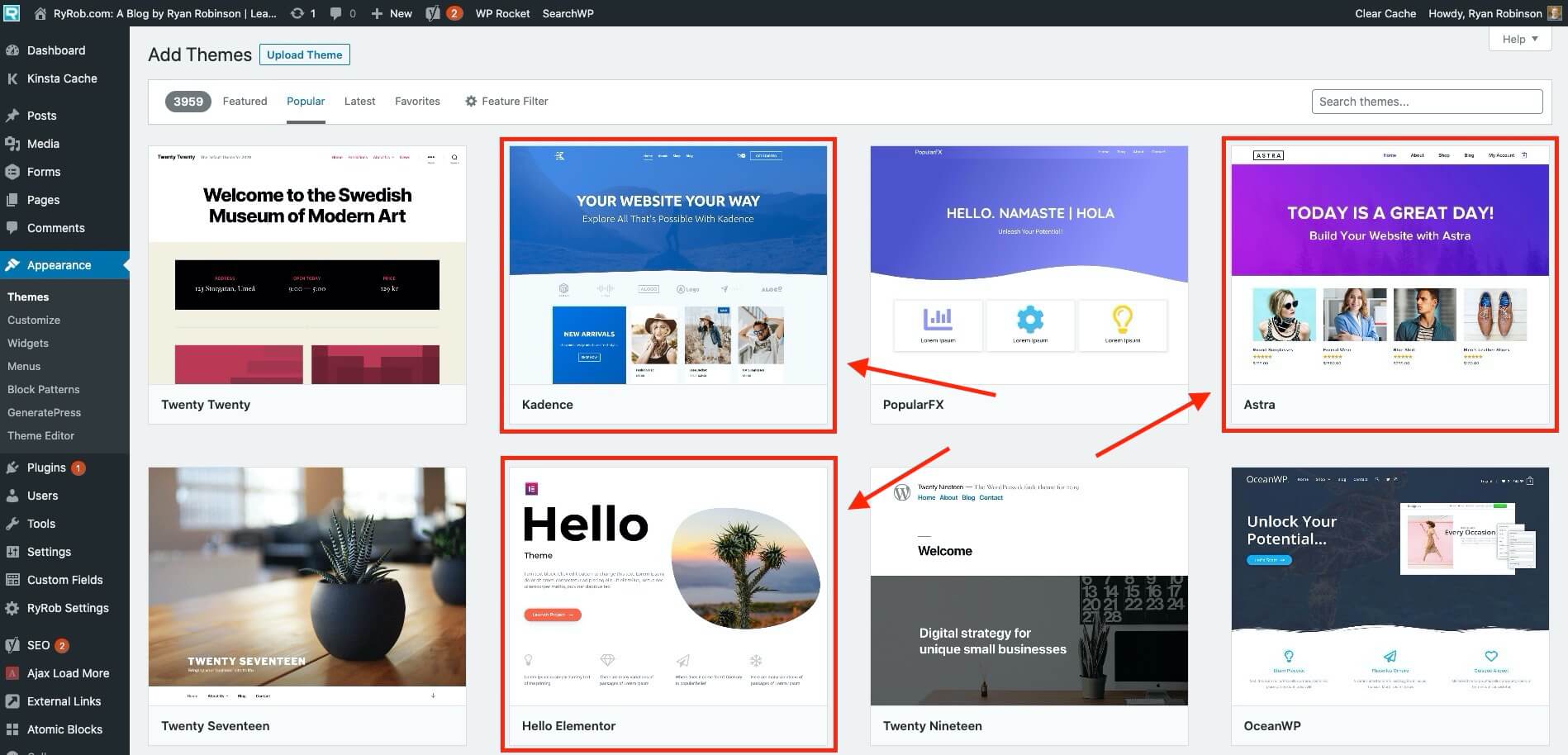
I like these three fast WordPress themes most because they’re crisp, clean, simple and will get you set up without needing to invest in a paid theme as you’re just starting your blog. Later, you can evaluate more of the other WordPress themes out there or upgrade these ones to their premium versions for more features.
What if I want to choose a different WordPress theme (or switch later)?
Why design is so important when starting a blog
Even if you don’t really care about design yourself, your readers will shift their behavior dramatically based on the features of your blog layout. In fact, during a 2012 study from Google and the University of Basel, researchers found that users judge a website’s aesthetic beauty and perceived functionality in 1/20th — 1/50th of a second. Plus, thanks to a little psychological bias called the Halo Effect, people will extend that judgement to all aspects of your blog.
Good blog design builds trust. It tells people that you care enough about your blog to make it look nice. This doesn’t mean you need crazy animations or tons of fonts and colors. In fact, the best designs are simple, clear and easy to read.
Once you’ve settled on the right theme for your WordPress blog, it’s time to dive into the world of WordPress plugins, to help unlock even more customizations and prep work in order to give your blog a chance of developing into a real business.
7 essential WordPress plugins you should install on your blog today
WordPress plugins play a crucial role in how your blog will function, and getting the most essential plugins dialed in as quickly as possible is a major step that’s designed to serve both your audience and perform well for search engines.
What is a WordPress plugin and why are they important?
The only problem with WordPress plugins, is that there are literally thousands of different plugins and blogging tools to choose from out there. To help you cut through all the noise though… these are the must-have WordPress plugins to install when you start blogging today:
- Yoast SEO: The more people that can find your content, the better your blog will do. The Yoast WordPress plugin helps you to optimize your blog post titles, descriptions, content length and other elements across your entire blog so that you can be found easier by search engines.
- WPForms: You’ll want your readers to be able to get in touch with you easily, which I highly recommend—as it’ll encourage other bloggers who want to collaborate with you an easy opportunity to reach out. WPForms is an easy-to-use plugin that allows you to drag & drop contact forms onto any page of your blog.
- Google Analytics Dashboard for WordPress: This is a 100% free Google Analytics plugin that allows you to see all of your relevant analytics data directly inside WordPress. Connect the plugin to your Google Analytics account (you can sign up for a free Google Analytics account right here) to find out who’s coming to your site, how long they’re sticking around, and what your most popular blog posts are.
- UpdraftPlus: Again, sometimes things will go wrong on your blog (and it won’t always be totally in your control). It’s always smart to have a backup plugin that’ll save all your hard work on a regular basis, and this free one stands high above the rest.
- WP Rocket: Faster websites rank better in Google and give your readers a better experience. WP Rocket is a plugin that caches your pages, reduces your file sizes, and does much more to ensure that your blog loads faster for everyone.
- MaxCDN: Speaking of speed, MaxCDN makes images and other static elements of your blog load faster as well, earning this plugin top marks to consider as a complement to also using WP Rocket.
- Insert Headers and Footers: Sometimes to edit your theme, you’ll have to add code snippets to your header or footer (it’s not as scary as it sounds). However, doing it in the code of your theme can cause issues. This plugin lets you add small snippets of code easily to select locations around your blog.
- Bonus — Lightweight Accordion: If you like the way I create the collapsible (accordion-style) content boxes here throughout this guide and in the FAQ section near the bottom of this post, then I recommend installing the free plugin I use to make those content sections come to life: Lightweight Accordion. In just a few clicks with this plugin, you can quickly add collapsible FAQ box functionality to your WordPress blog.
Basic WordPress blog settings to become familiar with now
There are many different reasons to start a blog and just as many unique goals you may have in mind. Regardless, it pays to have a basic understanding of the broader aspects of how WordPress functions, so that you can control the visual appearance of your blog.
Alright, we’ve covered the basic foundations of getting your blog’s WordPress settings dialed in. Now, let’s dig into creating a few of the main pages on your blog.
Creating the main pages of your blog (about, contact, hire)
From the moment you start a blog, you’ll want to showcase some basic information about yourself. Who you are. Why people should listen to you. How they can get in touch with you if they have questions or want to work with you.
These pages are all pretty standard, but they’re also a great way to have some fun and let your readers get to know you. In fact, I use my own About page to not only introduce who I am and tell my story but also to explain my value proposition (for potential clients looking to hire me as a freelance content marketer) and show recent achievements.
Here are step-by-step instructions for how to write an About Me page that does this on your blog, too:
How to write an About page for your blog
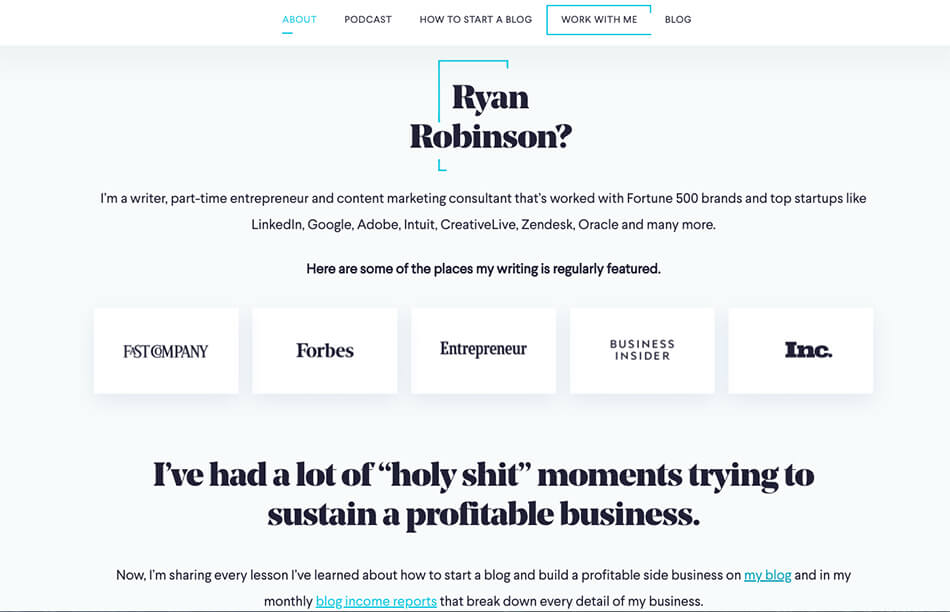
You might not think much about it, but your About page can quickly become one of the most popular pages on your blog.
Use your about page to show the value you’re creating for your readers—and work hard to earn that attention.
How to write a Contact page for your blog
Another often overlooked page that you’ll want to include early on when you start a blog, is a simple way for people to contact you.
While mine goes into more depth, your Contact page can be as simple as having your email and social media accounts listed on a page.
Think about what types of communication you want from your readers, and use your contact page to set those expectations right away.
4. Write your first blog post

You don’t read a blog because it looks nice or because they publish frequently. (Although those both help).
You read a blog because you care about what it says. Creating strong content is what will bring you readers and help you to eventually make money blogging.
- Why do you care for the topic you’re blogging about?
- Why should other people listen to what you’re saying?
- Why is this a topic that you can add value to?
To answer these questions, I like to think of a blog like any other business and re-emphasize the importance of picking a clear niche.
Ask these questions to determine a smart niche to start a blog in:
- What’s an interest or dream from your childhood that you find exciting?
- What’s the absolute best part of your day?
- Do you have any hobbies or hobbies that you want to learn?
- What is a deeply held value of yours?
- What’s one achievement that you’re incredibly proud of?
Right away, you should have an idea or two for a clear niche you could start blogging about. It’s ok if your niche grows, evolves and changes over time.
Taking it a step further: How to know if there’s a business opportunity for your blog niche
If you want to make money from your blog, you’ll also want to do a bit of research to see if there is a market demand for your niche. What this means is: Are people actively searching for what you’re writing about? And can you add value and help them in a way that makes you money?
Take the blog niche that you’re thinking about and come up with 5–10 keyword phrases or topics within that niche that you would write about. So, if we wanted to start a blog about playing guitar you might choose keywords like “best guitar books,” “how to play guitar,” “beginner guitar chords,” “what guitar should I buy,” and so on.
Now, let’s do a little keyword research. Enter one of those keywords from above into your Google search. If there are tens of millions (or more) results, that’s a pretty strong indicator that people care about your topic. But to be extra sure, I like to use a free tool like Twinword Ideas to check the Monthly Search Volume (how many people are searching for this term each month).
Do this for each of your keywords and look at the results. If all of your top keywords have a Monthly Search Volume of 5,000 – 10,000, you’ve definitely got a potentially profitable niche. If you’re too much over that, into the high hundreds of thousands of Monthly Searches, you might want to get more specific with your niche rather than competing with much larger, established websites on more popular subjects.
Brainstorming smart blog post ideas (using keyword research)
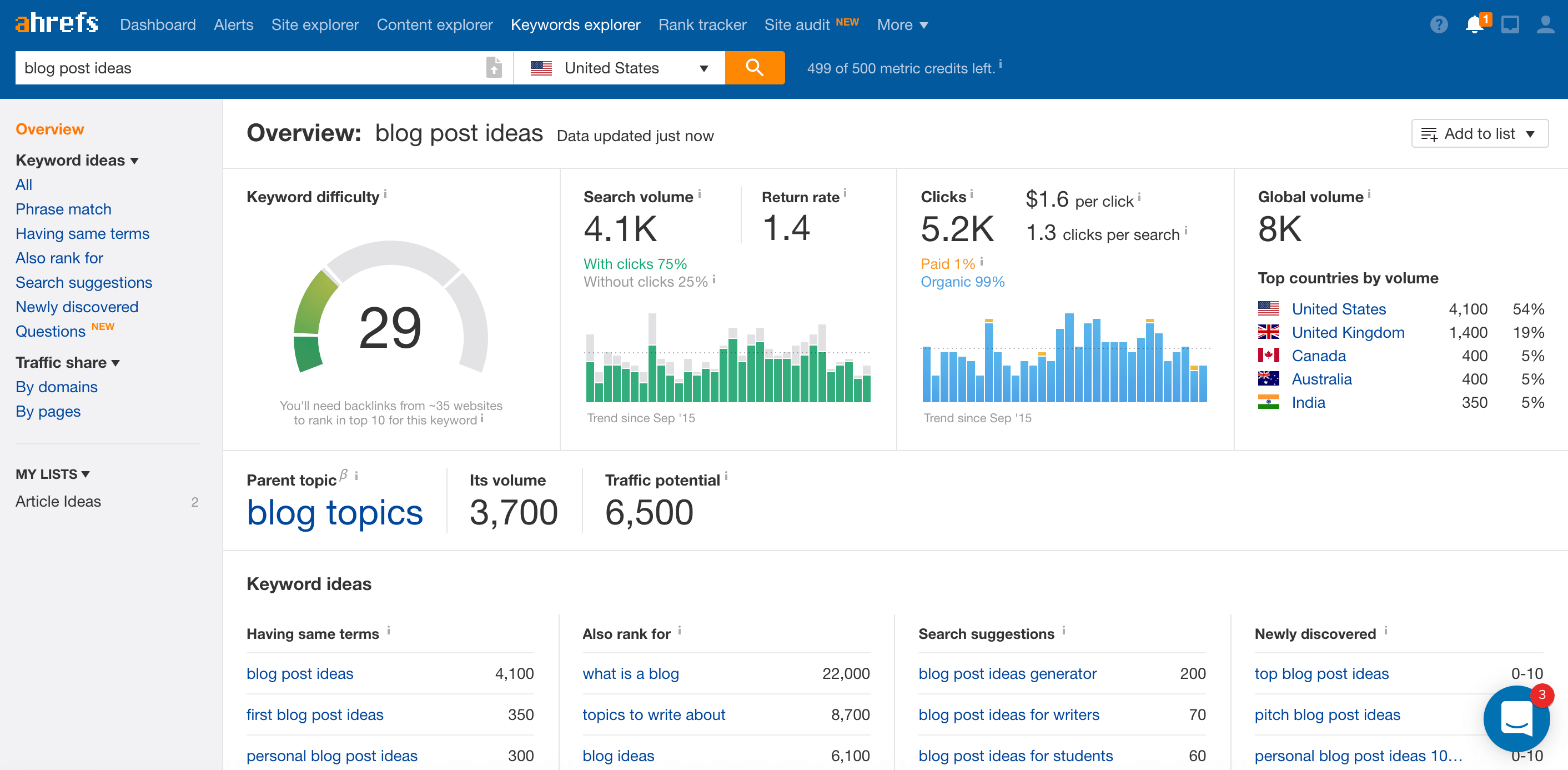
Even once you’ve established the niche you’ll be blogging about, you have to do smart keyword research in order to generate the right blog post ideas that’ll actually bring you readers.
So, what about the actual posts you’re going to write? The good news is you can honestly write whatever you want! This is your blog after all, and one of the major benefits is that it’s your platform to speak and share. But, ideas don’t always come naturally.
This is where I believe a simple editorial calendar is so important. It’s just a basic document to fill out that’ll give you a roadmap to always knowing what you’re writing next. It frees you up to spend more time on the fun of actually putting posts together—not banging your head against the wall trying to come up with blog post ideas.
5 ways to come up with clever blog post ideas
Here’s a simple process I use for coming up with the specific blog posts I write for my own blog.
If I’m still left needing more ideas, I’ll turn to a few more creative tactics…
- Seeing what other bloggers in my niche covered (and what did well).
- Taking a look at my most successful posts to see what readers like most.
- Doing more quote roundup posts (like my posts about business advice and online business tools) that don’t require a ton of original thought and effort from my end.
- Chatting with bloggers in my space and brainstorming fresh ideas.
- Talking about specific lessons I’ve recently learned (and my advice).
- Reflecting on the blogging mistakes I’ve made and the tactics that work today.
Now you’re ready to write your first blog post
Once you’ve decided on the first blog post you want to write, you’ll navigate to the “Add New Post” section from your WordPress Dashboard.
Go to Posts > Add New which will look like this right here:
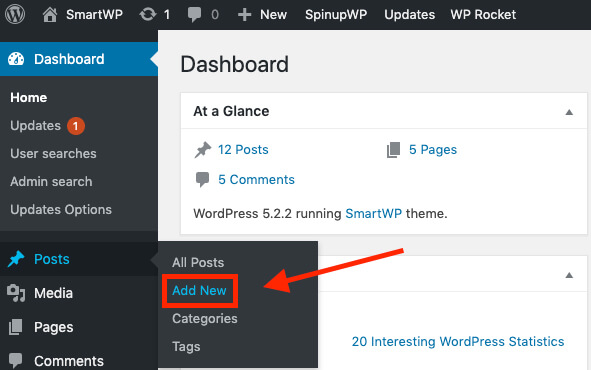
Next, you’ll be taken to a brand new article page that’ll look like this (a totally blank canvas 🙂):
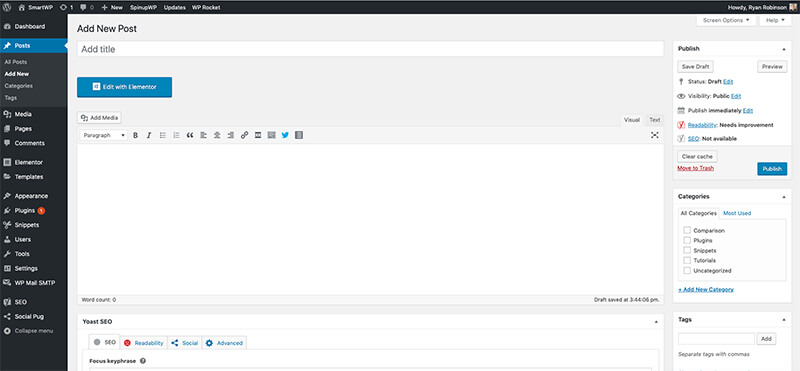
Writing a blog post headline that encourages readers to click through
One of the reasons you’re blogging is to attract readers, right? Well, it pays dividends to put some effort into learning how to write a headline that’ll entice readers and most importantly—deliver on the promise of what your article is actually helping readers to accomplish.
So let’s say you’ve determined that your hiking blog should start by breaking down some underrated hikes in Northern California. Next, click into the “Add title” bar on your new post page and type in a title like…
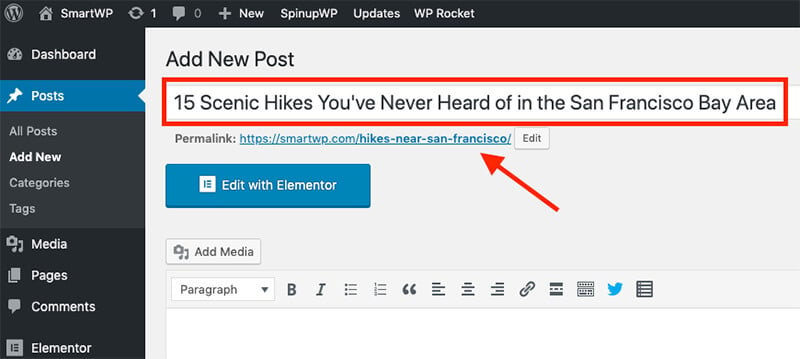
As a starting point to writing a strong title, learn by observing the headlines of other successful bloggers in your niche:
- Do they often lead with numbers?
- How many of their article headlines include parentheses?
- Does it seem like a best practice to capitalize the first letter of every word?
Check out a few of the most recent headlines from my blog so you can get some inspiration on how you might want to structure your headlines (and read my ultimate guide to writing blog headlines).
If you’re still unsure about how to title a new post, then do a Google search for the target keyword phrase you’re going after and gather inspiration for the ways other titles are written—be sure not to directly copy other bloggers, but that’ll point you in the right direction.
Choosing an SEO-friendly blog post URL
It’s extremely important that you customize the URL of your new post, if you hope for it to rank well in organic Google search results.
How to set an SEO-friendly URL for your blog posts (click to expand)
Crafting a compelling introduction to your new blog post
You have one or two sentences to convince readers your new post is worth their time. Here’s a sample blog post introduction I just wrote in less than two minutes for our hiking example:
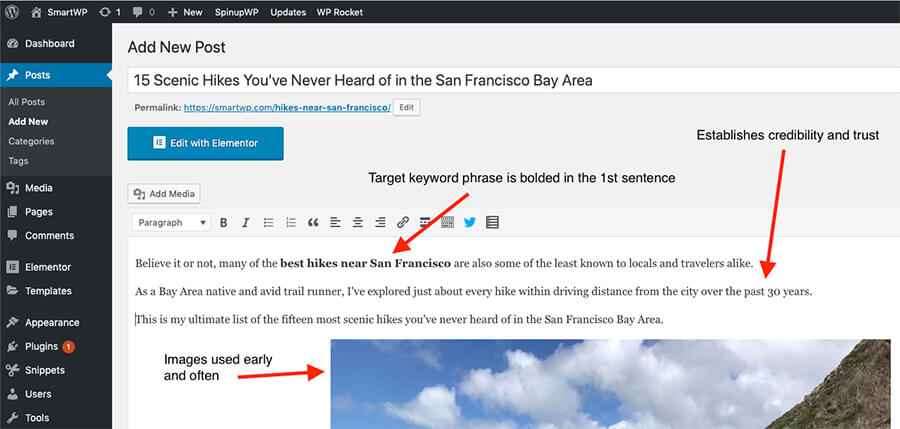
As you’re learning to write a blog post that keeps readers engaged, here are a few do’s and don’ts for crafting a strong introduction.
The do's and don'ts of writing a blog post introduction (click to expand)
The easiest strategy for writing a compelling introduction is to answer the who, what, where, when and why as soon as possible. This may sound counterintuitive, but another trick is to start with your conclusion first. In the age of short attention spans, people have grown tired of wasting time on clickbait blog posts that go nowhere.
The quicker you can establish relevance to your reader, give them a strong reason to believe they’ll find what they’re looking for in your blog post, the more likely they’ll be to dig into your piece and share with others.
Optimizing the design and layout of your blog post
Ultimately, what looks “good” is subjective and up to you, based on what you think your (future) readers will resonate with most. But one of the most important lessons I’ve learned through starting a blog of my own is that design matters a lot.
These five time-tested design principles will be immensely helpful in constructing an appealing blog layout (that’s easy for readers to digest).
Hitting publish on your first blog post
Once you’ve written your first blog post (and ideally get it to the 1,000+ word range) you’re almost ready to publish!
Take a few minutes to double check on the Yoast SEO suggestions and ensure your blog post is SEO-friendly, which will give you the best chance of ranking well in organic search.
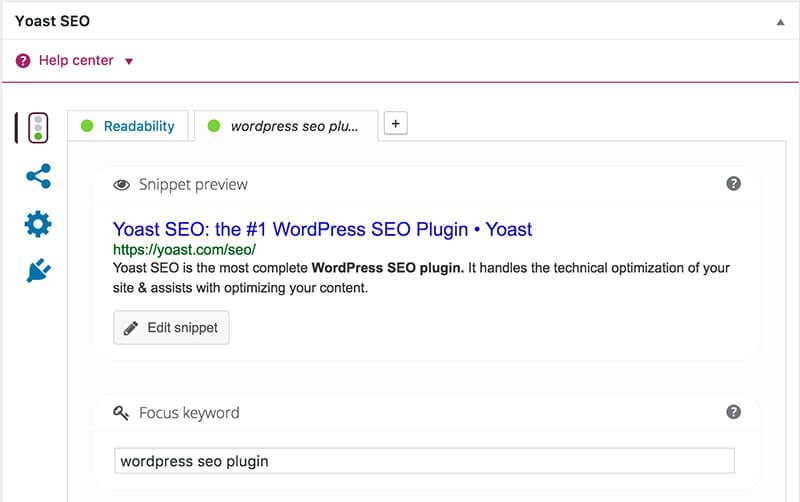
After your SEO settings are dialed in, choose which “Category” this new post will fall under and tick that box. Then, you’re ready to hit publish!
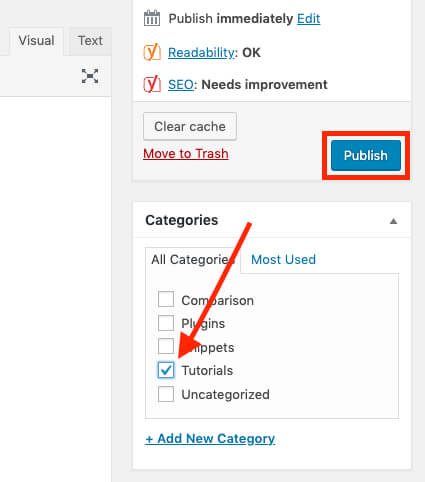
And boom! It’s that easy if you allow it to be 🎉
Now, if like me, you appreciate great design—before you hit publish on your first blog post, there’s one last step you could take.
Studies show that blog posts with images get 94% more views than those without. And when it comes to posts getting shared on social media, tweets with photos get 150% more retweets that those without one, while Facebook posts with images get 2.3X more engagement. Adding a few visual elements can almost double your amount of views and expand the shares a blog post gets.
Free blog photo resources
One of the easiest ways to add some visual flair to your blog posts is with beautiful images and designs. Thankfully in recent years, there are now a number of high quality sites that offer incredible photography that’s completely free to use for your blog—my favorite is Unsplash:
Unsplash (for free blog images and stock photos)
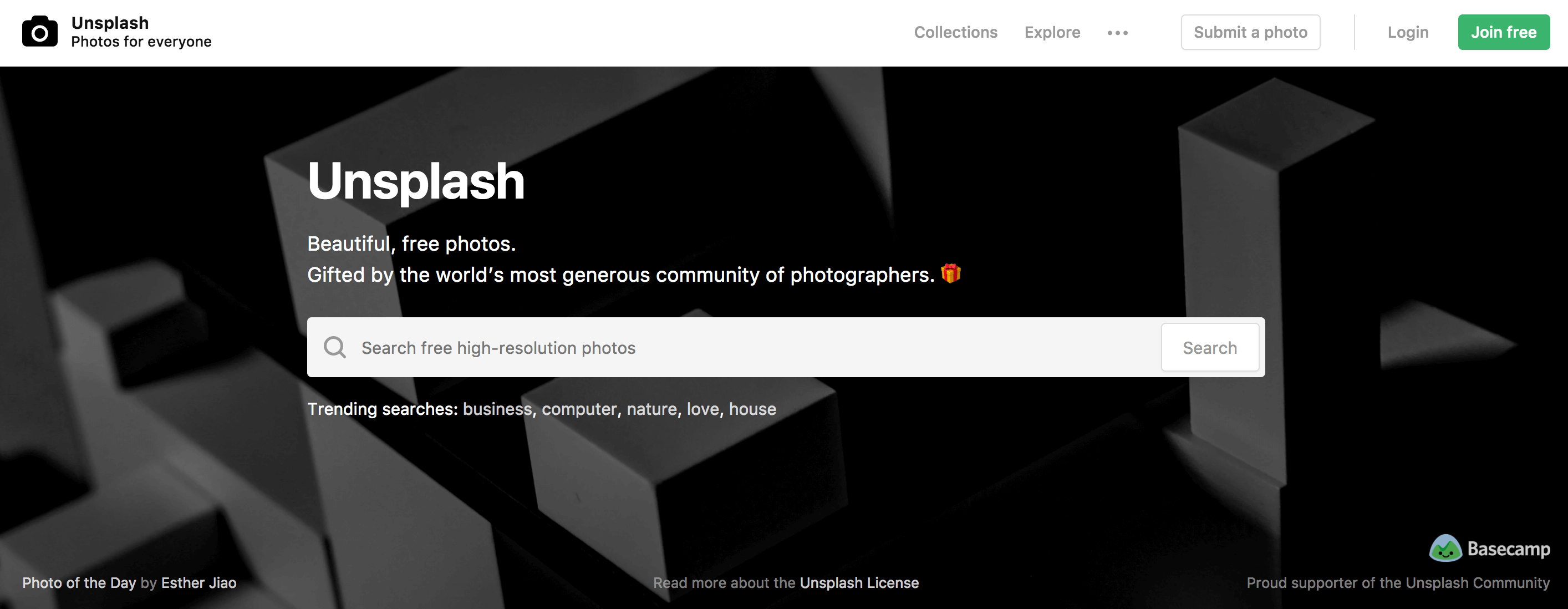
Unsplash is the best online resource for completely free, user-uploaded photos for your blog. Every photo that makes it onto Unsplash is curated by their team to make sure it’s high quality. Under the Unsplash license, you don’t even have to attribute the photographer (however, they recommend you do), which makes Unsplash the easiest option for free blog photography.
Other great free blog photo resources worth mentioning
- Wikimedia Commons: 21+ million photos and images from throughout history that are now in the public domain and free to use.
- Life of Pix: Awesome free-to-use photos donated by an advertising agency in Montreal, Canada.
Bonus: Creating a blog content strategy
I’ve been lucky enough to work for some fantastic companies and get paid to learn about the importance of having a content strategy for your blog. I’ve successfully applied those same lessons to my own blog—making many tweaks and additions along the way.

Here’s how to create a basic blog content strategy today:
- Define your blog goals: What’s your purpose for starting a blog? What do you want to achieve with your blog content? This goal might change as you grow your blog, but it’s still important to know it early on.
- Get to know your blog readers (and where they hang out): Your readers will determine whether or not your blog becomes successful. To write for them, you need to really understand them—which is why it helps if you’re also writing for yourself. It’s useful to some research around the audience you’re writing for. Think about the demographics and psychographics of your target audience. Demographics are the quantitative traits of your readers (age, gender, location, job title) and psychographics are the more unmeasurable traits like values, interests, attitudes and belief systems. Once you’ve written down these qualities, you can start to come up with an audience persona—a fictionalized version of your ideal reader.
- Decide on your blog’s main content pillars: When it comes to deciding what you’re going to write about, it’s good to have a few guiding categories that you’ll refer back to. I like to call these content pillars, as they’re the foundation that holds up the rest of your blog. For example, if you’re starting a blog about personal finance, your pillars might be: personal finance tips, interviews with experts, industry news, paying off debt or otherwise. Each of these pillars can have hundreds of blog posts written under them. They also all work together to show that you’re a thought leader in your niche.
- Map out the content you’re going to create soon after starting your blog: Shortly after launching your blog, it’s worth taking a little time to plan out your content pipeline for the coming weeks (possibly months). You never know when your first blog post might go viral. In that case, you’ll want to have at least a game plan to quickly engage the new readers you get. Even just one or two blog posts under each of your major content pillars is enough to start with.
We’ve now come a long way in this guide. You’ve gone from learning the technicalities, all the way through to publishing your first post.
It’s time to talk about what happens after you’ve published your first blog post… promoting your content, driving traffic and eventually making money from your blog.
5. Promote your blog and get readers
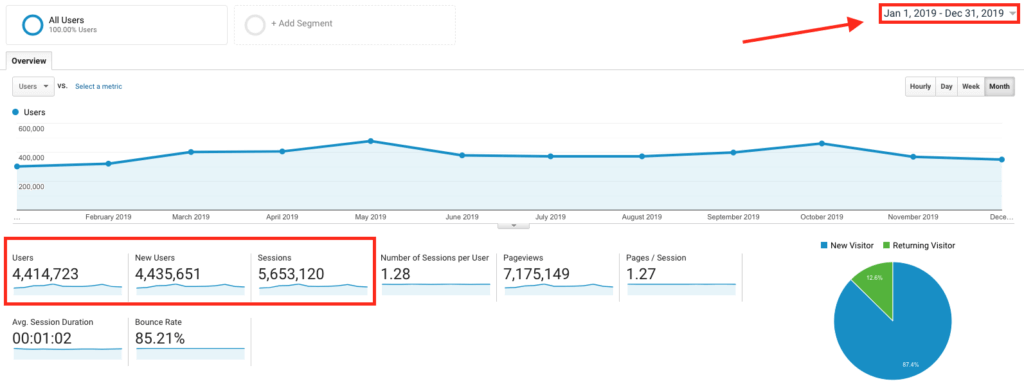
Now that we’re closing out 2020, we can look back and see that my blog brought in 4.4 million+ readers last year alone. We’re going to use my experience in going from starting a blog—to quickly driving millions of readers to my content. What do you do once you’ve hit publish on your first blog posts? It’s time to learn how to promote your blog content.
This is the reason I’m hired as a consultant by companies like LinkedIn, Zendesk, Adobe, Close, Intuit and more—to write content for their blogs, teach them how to promote their content and bring in new readers.
Here are a few of the best ways to start sharing your blog posts and getting them in front of new readers. And if you want even more strategies, here’s my guide to learning how to drive traffic to your website where we dig even deeper into the tactics I’ve used to grow my blog to millions of yearly readers.
Using social media to promote your blog
The obvious first place to turn when you want to find readers is social media. Facebook, Twitter, YouTube, Pinterest, LinkedIn, Reddit, Instagram, Snapchat and TikTok are some of the biggest networks today. Whichever platform best suits your niche and audience interests, is the right one for you. And that’s an important note. There’s no point in trying to promote your blog posts on every social media platform.
Look for the social channels that give you the best return
The key insight here is that you’ll need to experiment and see which networks will perform best for you.
One of the best things about starting a blog is that you’re joining a community of other bloggers that love to help each other out. Guest blogging on other relevant sites is the #1 best way to connect with an already established audience. Check out my ultimate guide to guest blogging for a full walkthrough, but we’ll cover the highlights here.
I’ve written literally hundreds of guest posts over the past decade, and it’s been the single best strategy for promoting my blog content.
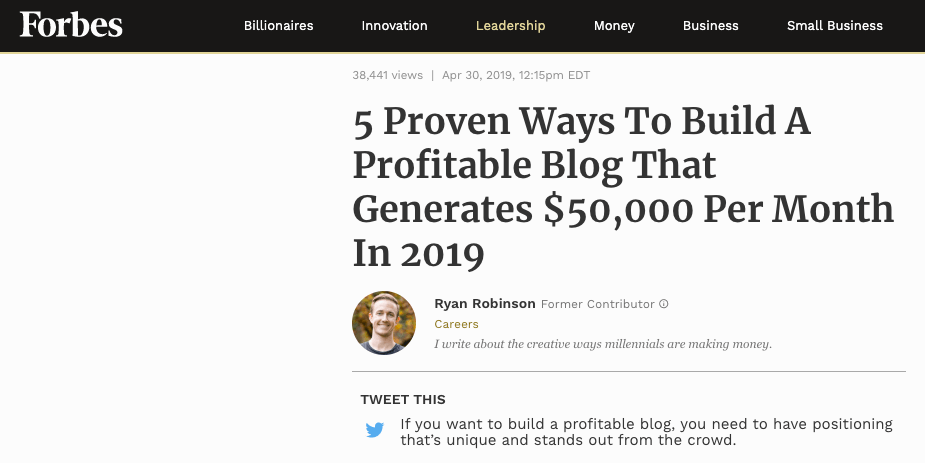
The key point to all of this, is that you want to look for places where your audience is—and be present there, whether that’s other blogs, communities, or social platforms.
Forums and message boards for bloggers
Often, just throwing your ideas out into the social media void isn’t very effective.
Instead, being a part of targeted forums and online communities can give you a way better return on your time—if you find the right ones. Browse through relevant groups on Facebook to see if there are any vibrant communities that’d be a good starting point.
Now, if your search doesn’t come up with any Facebook Groups with a decent number of members (5,000+), there are other options. Look for more general groups that relate to your niche on Facebook, LinkedIn, Reddit or standalone forum websites.
Remember, forums and message boards aren’t just places to dump links to your blog posts. You need to provide value before you ask for anything in return. So, start by building relationships and engaging with people there.
Using an email newsletter to grow your blog audience
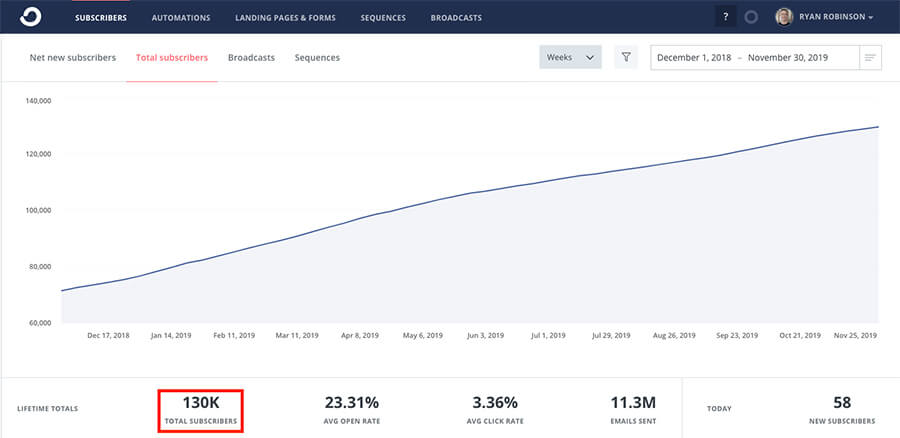
One of the best forms of blog promotion isn’t to other audiences, but to your own (over time). An email newsletter is the most powerful way to keep existing readers engaged with the work you’re doing and one of the things you should set up immediately.
Building your email list can be relatively simple, too. Place a signup form within your posts and across key pages of your site. I use a tool I love, called ConvertKit, to manage the 150,000+ email subscribers I now have on my blog, but Mailchimp is the best free email marketing tool to get started with.
Not sure which email marketing tool to use when starting a blog?
Read through my detailed comparison of ConvertKit vs AWeber vs Mailchimp for my take on where you should start and when to upgrade to more robust email marketing tools.
I send my community an update whenever I post a new blog post, have a resource I want to share, or when new podcast episodes go live—and this now ensures my content will quickly be seen by thousands of people right off the bat. Email marketing has by far been the biggest driver of growth and revenue for my blog, and something I can’t suggest enough amongst all the blog marketing strategies you can invest in.
Other ways to promote your blog and get more traffic
Outside of promotion on social media, through guest posts, in forums and over email—here are a few other techniques I’ve personally used to grow my blog audience quickly.
Remember that the only thing standing in the way of growing your blog is you. It’ll take some ingenuity and the willingness to experiment, but it’s well worth the effort.
Almost every guide about how to start a blog stops long before this point. Now, I’m going to equip you with the tools (and strategies) to go from starting your new blog—to building a true business around it—based on my experience growing this blog to more than 500,000 monthly readers and $50,000/mo in revenue.
Let’s talk about how to (eventually) make money from your blog.
6. Make money from your blog
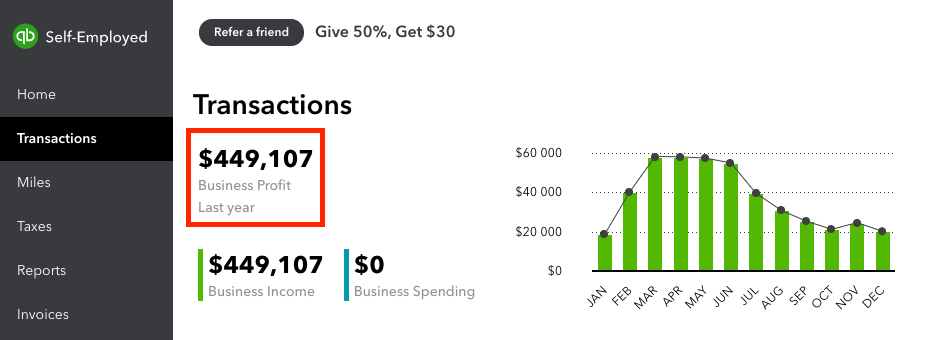
Last year alone, my blog generated $449,107 in revenue (ignore the $0 in expenses here, you can see those details in my blog income reports).
I share this not to brag, but so that you’ll understand I know what I’m talking about when it comes to starting a blog and making serious income with it. Moreover, I’ll be the first to tell you that these kinds of income figures aren’t typical with blogging—and that it’s taken me 6+ years to reach this point in my blog business.
There’s a reason why making money from your blog is at the end of this guide to starting a blog. Unless you have a huge audience somewhere already, you can’t expect to make money right away—monetization should not be your #1 focus at the moment, but rather something to work towards.
Even still, it’s good to have an idea of which ways you’d like to make money blogging as you go into this new adventure. Some of these monetization strategies will be easier than others to implement while your readership is still growing.
1. Freelancing (Selling Your Services)
If you want to begin earning from your blog as quickly as possible, then selling your services (by landing blogging jobs, freelance writing gigs or otherwise selling your expertise as a service) is the easiest option by far. In fact, up until very recently, I was still freelancing as a blog monetization channel for my own business:
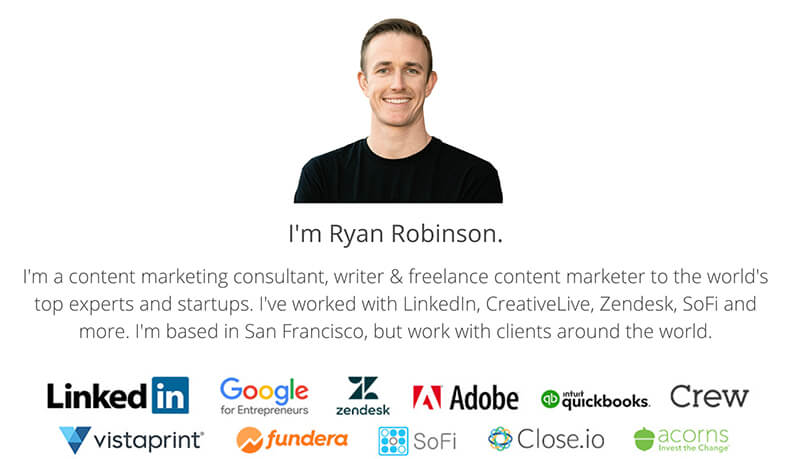
All you really need in order to land a freelance client, is a strong enough pitch, which is where choosing to start a blog (first) will help significantly. You’ll want to build out your key pages (About, Contact, Hire Me) and showcase at least a couple examples of the type of work you’ve done that you’ll soon be pitching freelance clients on.
If you don’t have those work samples yet… don’t let that hold you back. Create those sample articles, designs or other deliverables and host them on your own blog as if they were a project you got paid to produce.
If you have a skill that you can sell as a service, then you’re already prepared to go out and start pitching potential clients. That skill could be something like…
- Writing (one of the top blogging skills you’ll want to command)
- Design
- Photography
- Marketing
- Developing (check out these WordPress developer job sites)
- Public relations
- Social media management
- Virtual assistance
- Community-building
- SEO or paid advertising campaigns
- Business strategy or project management
- The list goes on… because any skill can be monetized
Today, I still regularly book new freelance clients (like LinkedIn, Zendesk, Adobe) for $5,000/mo or more and I’m brought on to advise and execute on creating blog marketing campaigns for their organization.
If freelancing sounds like your cup of tea, you’ll want to grab my (free) collection of all my best resources, tools and templates for freelancers. That resource bundle is the culmination of more than 8 years of refining my freelance contract template, proposal template, cold email templates that convert new clients and more.
I also put together an in-depth guide to getting started with freelancing that you’ll want to read and another great foundational read about how to develop a pitching process that works for your type of business, is my freelancer’s guide to cold emailing. And if you want to try out some of the websites where freelance clients are already looking for talented help, here are my lists of both the best blogging job sites and the best freelance job sites.
2. Affiliate Programs
Every month, I earn a substantial amount of passive income from the affiliate programs that I’m a member of (sometimes in excess of $50,000+). For example, here’s a screenshot of my blog income from just one affiliate program (Bluehost) for the first 5 months of last year.
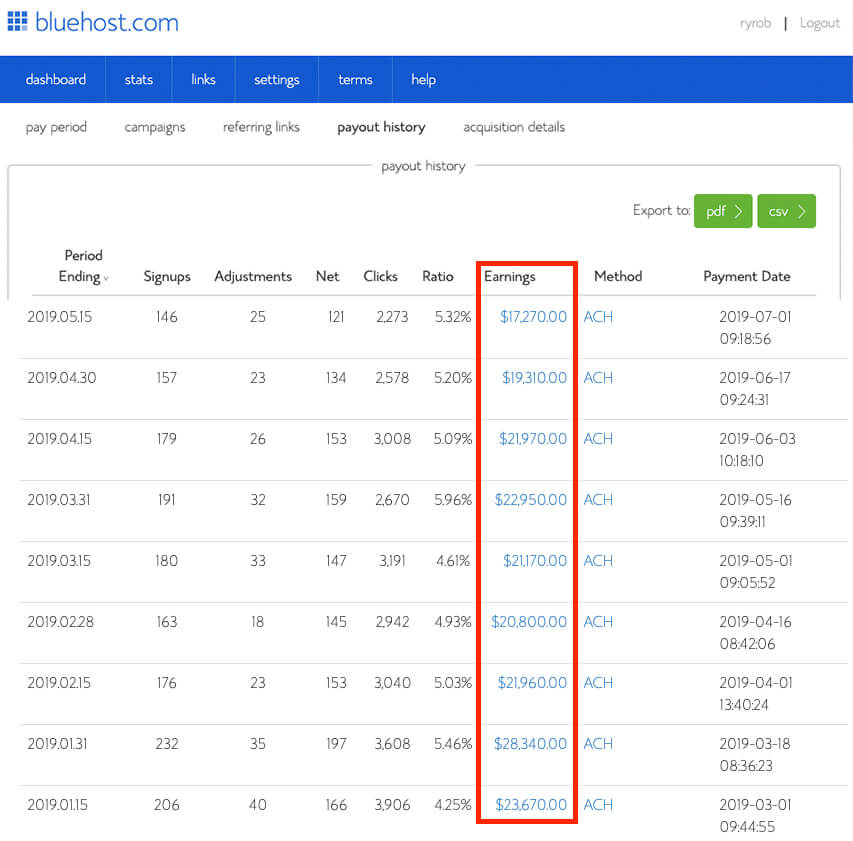
Since starting a blog here a little over 7 years ago, affiliate income has gradually grown to become the largest revenue source for my business—and I’ve structured my blog to generate affiliate income because of how passive it is once you’ve done the (hard) work to find a sustainable traffic source for your content.
Most of the biggest brands have affiliate programs. Think companies like Amazon, all the way down to key players in specific niches like online education where brands like CreativeLive and Udemy have lucrative programs. Here’s a snapshot of my recent earnings from just a couple of other programs:

Once you build a small readership, you can go out and broker a more advantageous affiliate deal with companies that have relevant products you want to promote to your audience. For a LOT more on the subject of monetizing your blog with affiliate income, check out these guides:
3. Sponsored Blog Content
Unless you already have a decent-sized audience on your blog (or social accounts), it’ll take some time to grow your readership to a point where the sponsored content is a viable monetization option.
The best way to do sponsored content without alienating your readers is to weave it into your typical publishing style.
4. Online Courses
Once you have a skill (or experience) that others also want to learn, it’s relatively easy to package your best advice (like my blogging tips), strategies, tactics and tutorials into an online course where people can pay for access to accelerate their learning much quicker than they otherwise would going through the stumbling process of learning through trial and error.
Last year alone, I generated over $60,000 from the launch of my premium blogging course, Built to Blog, which takes students far beyond just starting a blog and into advanced strategies for getting readers & generating revenue from their blogs.
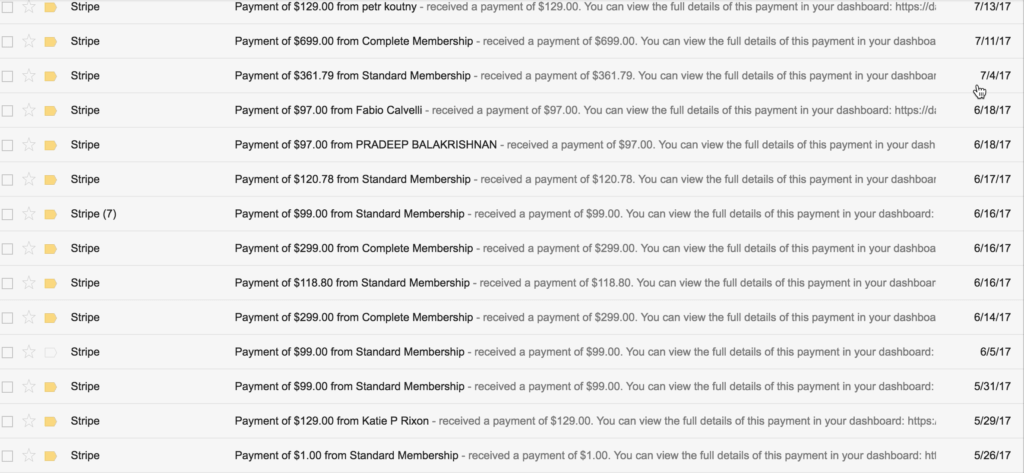
What’s great about an online course as a monetization path for your blog (or like I’ve done with selling blogging books too), is that you don’t need a huge audience in order to earn from online courses. The same goes if you choose to write an ebook and sell that digital product to your audience.
How to launch a profitable online course (click to expand)
5. Traditional Blog Advertisements (Ad Networks)
I used to have several small blog advertisements displayed across my content (from one of these top blog advertising networks) that would earn me around $1,500 to $2,000 per month in incremental revenue, before I turned advertisements off in favor of optimizing for other sources of income.
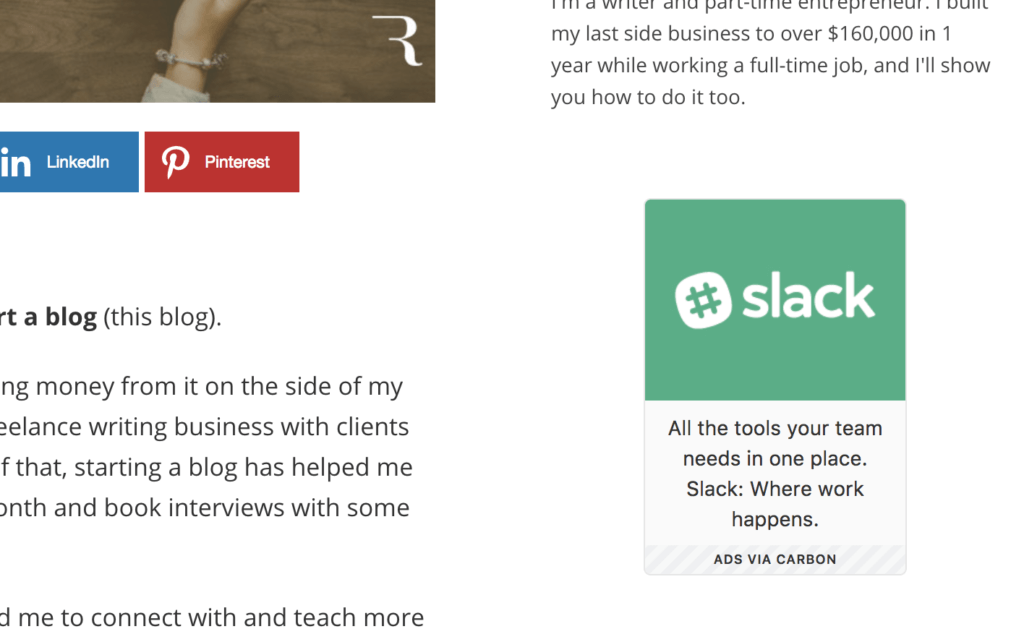
I was a member of a small ad network called Carbon Ads for the first few years of my blogging journey, where they partner with bloggers and pair us up with ads from high-quality startups like Slack, Asana, Freshbooks, Monday, Upwork and other targeted brands that my audience is already familiar with.
All in all, traditional CPC or CPM advertising doesn’t become very profitable (at least as a viable source of substantial blog income) until you’re driving more like 1 million+ monthly readers, so it’s not a great monetization channel to focus on in the short-term. But, when you’re starting a blog, it can be one of the easiest ways to make money from your traffic without much extra effort.
6. Podcast Sponsorships
Another great way to start monetizing your blog is by launching a (simple) podcast for your readers. You can use your traffic and early listener numbers to book sponsorships from brands that want to reach your type of readers & listeners. Here’s the growth trajectory of my podcast over it’s first year:
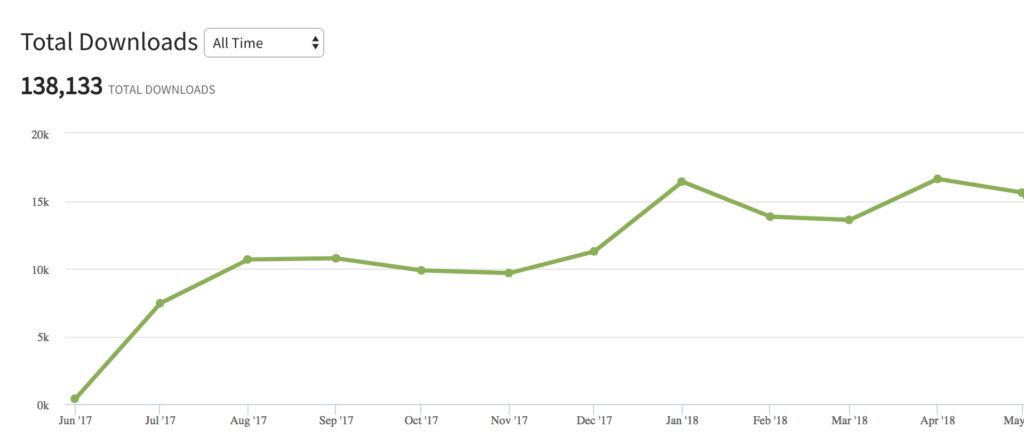
You can even combine podcast ad placement offers with sponsored blog posts on your site to really sweeten the deal. And I understand that launching a podcast while you’re still mastering blogging sounds like a diversion, but keep in mind that a podcast can be as simple as casual conversations with other bloggers in your industry.
How to make money with podcast sponsorships
For many more on the mechanics behind launching a podcast and monetizing it alongside your blog (including choosing the right podcast hosting), check out this episode of my show with Michael Sacca of Rocketship, whose grown his podcast into a $10,000/mo source of side income while he still holds onto his day job in sales and marketing. It’s a true masterclass in starting a podcast that you don’t want to miss.
7. Physical Products (eCommerce) and Software Tools
Similar in concept to launching an online course to your blog audience, another great way to monetize your audience is by selling a physical product or software tool to the people in your community—especially if you’ll be starting an eCommerce store (with the right eCommerce website builders) to sell products that are related to what your readers need.
At the end of the day, this one all comes back down to solving the problems your blog readers have.
What once used to be a much more labor-intensive business, eCommerce has become a great way to monetize an audience of readers on your blog—especially with the proliferation of drop shipping and order fulfillment services.
On top of just selling to your own audience, you can leverage loyalty programs that incentivize customers to invite friends to purchase with offers like first-time customer discounts, free one-month trials, gifting programs and more. These channels create opportunities for amplifying your message and spreading your products through word-of-mouth marketing efforts that won’t cost you anywhere near that of similar advertising fees.
8. Business Partnerships
Of all the ways to monetize your blog, this is the most amorphous. Who knows who you’ll meet as a result. What about future guests on your podcast? The possibilities here for stumbling into partnership opportunities are endless.
As a result of sticking with my blog for several years, I’ve been able to use it as a tool to meet some incredibly talented entrepreneurs. Here are a few examples of how my decision has turned into profitable partnerships:
- I’ve collaborated with my friend Jory (a writer) that I met because of my blog, on growing a $10,000/mo content marketing agency together
- I’ve launched new websites (like SmartWP) with my friend Andy who has a similar audience as my own
- I’ve worked with a former podcast guest to help build a software tool I’ve envisioned for years
It’s true that there aren’t as many ways to authentically engineer the creation of these types of partnerships—aside from growing your brand and the reach of your blog—then being receptive to the creative people & ideas that come your way as they discover you.
On the flip side, if there’s someone in your space that you really want to collaborate and work with, strategize on a way you can add value to their business.
How to Start a Blog in 2021: Final Takeaways for New Bloggers
Ultimately, growing a successful blog all boils down to being excited and engaged with your new blog. If you want people to read what you’re writing, you need to give them a reason to.
Write exciting content, connect with people in your niche and enthusiastically share what you’re working on.
The traffic, monetization and everything else will follow.
I wrote this guide because starting a blog has been one of the most empowering, life-changing decisions I’ve made in my life.
And I hope that by now you feel confident enough to go out there and start a blog of your own.
I’d love to have you in my free 7-day course that expands on the teachings of this guide. We also dive even further into topics like driving traffic, my personal writing process, monetizing your blog and more.
Infographic: How to Start a Blog (for Profit) This Year
For those more visual learners, I also put together this infographic breaking down the process of starting a blog—and my personal experience generating both traffic and revenue from your blog. Enjoy!

Quick Summary of How to Start a Blog in 6 Easy Steps
To sum things up, you need to:
- Pick your blog’s name and niche
- Get your blog online (web hosting)
- Design your blog with a free WordPress theme
- Write your first blog post
- Promote your blog and get readers
- Make money from your blog

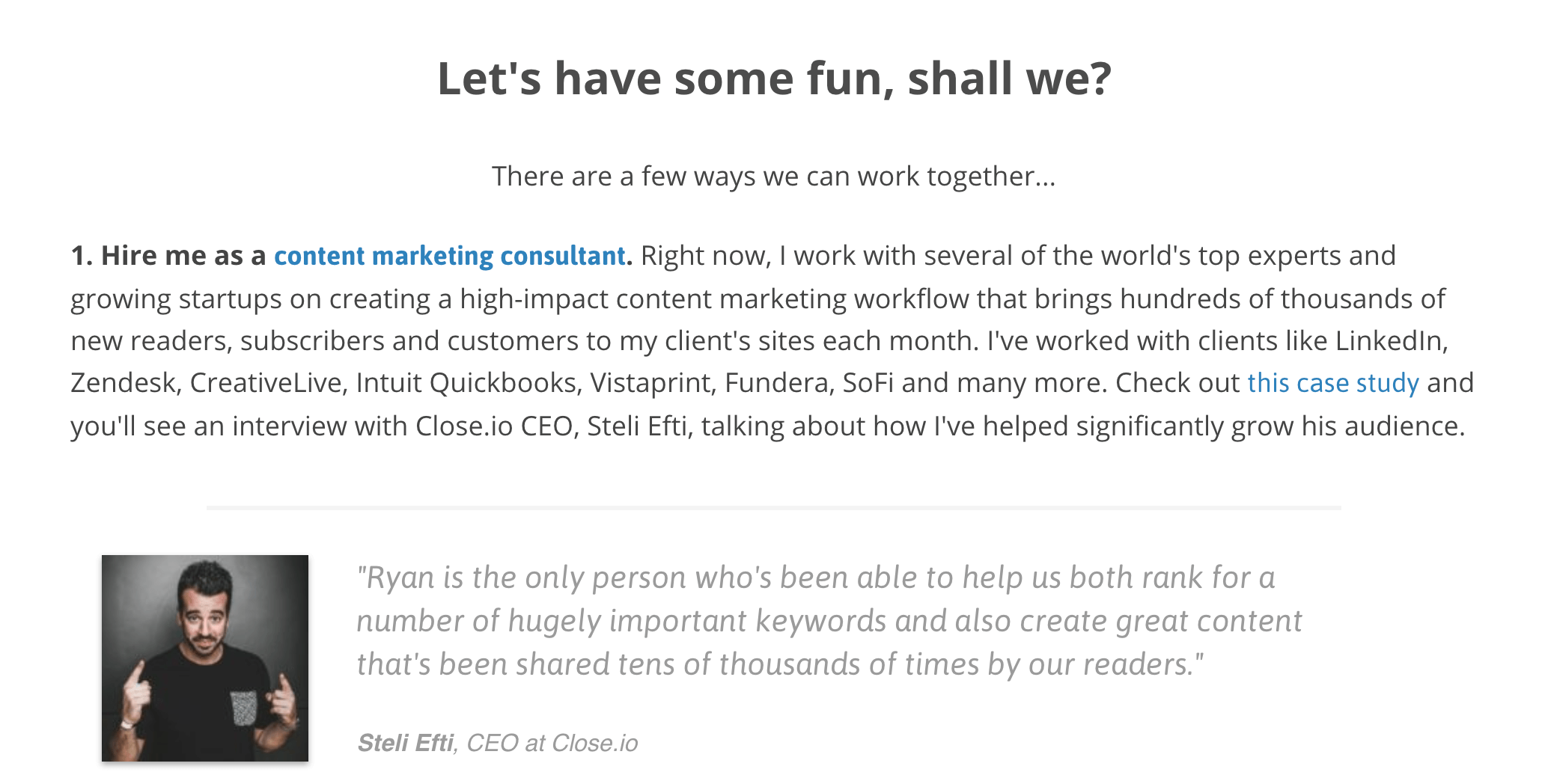
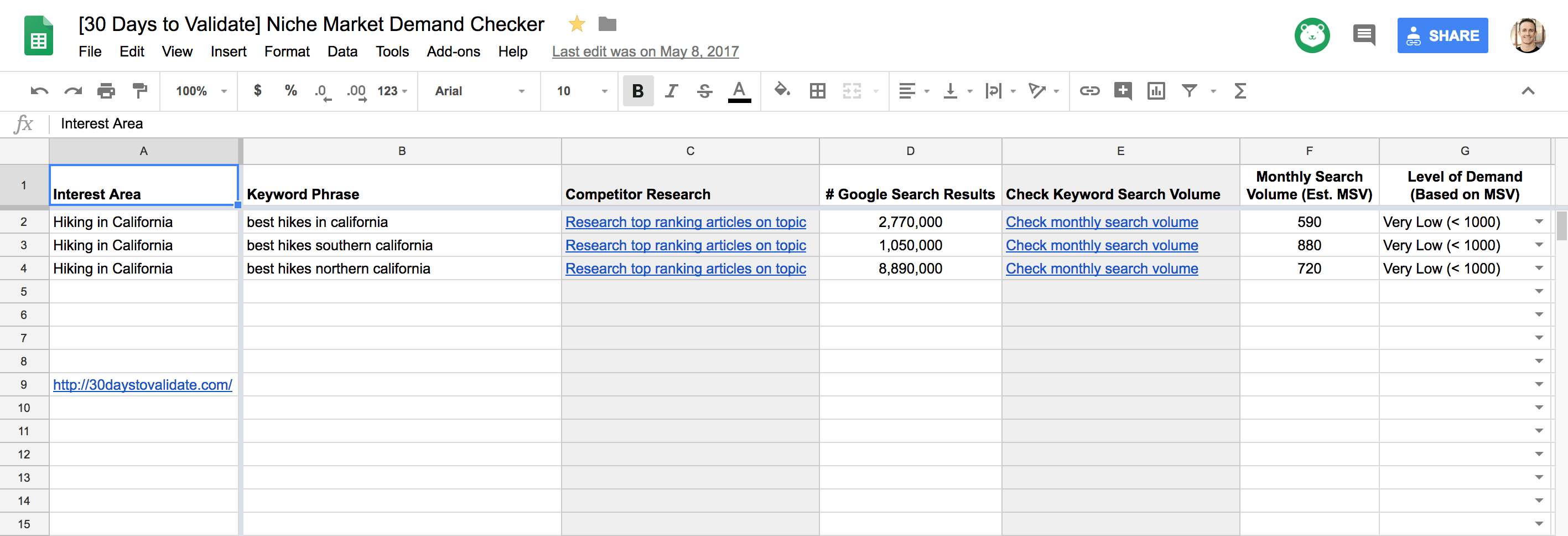




0 Comments